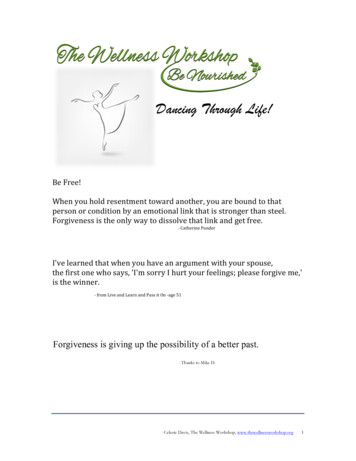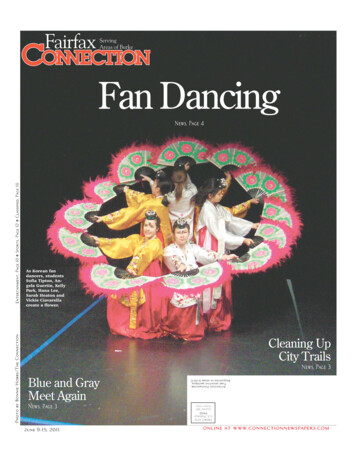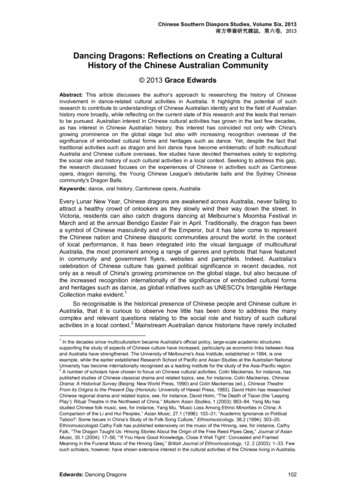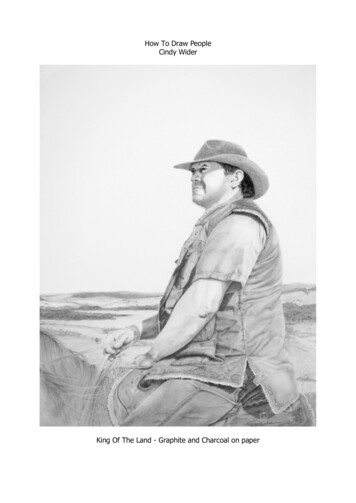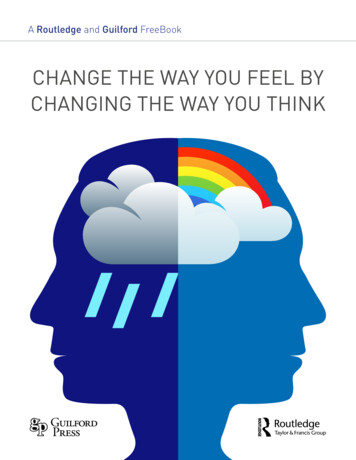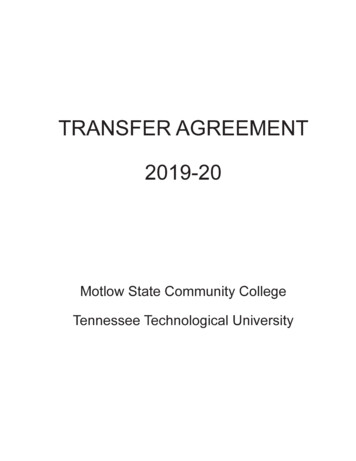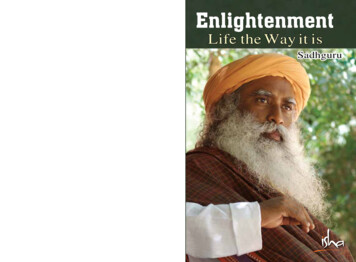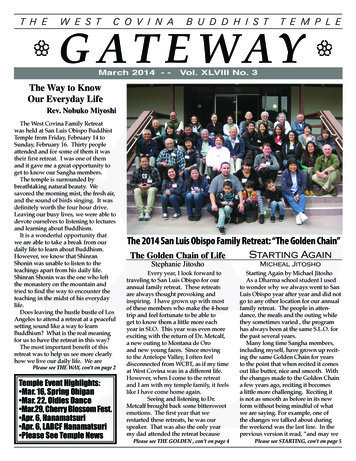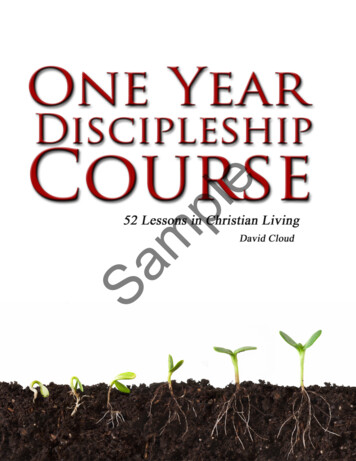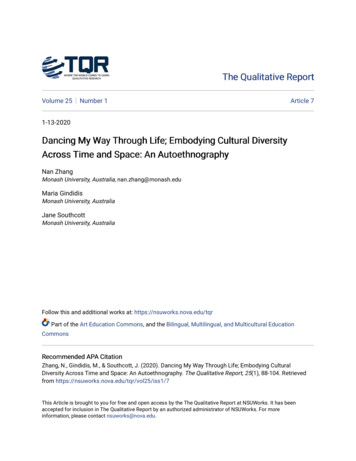
Transcription
The Qualitative ReportVolume 25Number 1Article 71-13-2020Dancing My Way Through Life; Embodying Cultural DiversityAcross Time and Space: An AutoethnographyNan ZhangMonash University, Australia, nan.zhang@monash.eduMaria GindidisMonash University, AustraliaJane SouthcottMonash University, AustraliaFollow this and additional works at: https://nsuworks.nova.edu/tqrPart of the Art Education Commons, and the Bilingual, Multilingual, and Multicultural EducationCommonsRecommended APA CitationZhang, N., Gindidis, M., & Southcott, J. (2020). Dancing My Way Through Life; Embodying CulturalDiversity Across Time and Space: An Autoethnography. The Qualitative Report, 25(1), 88-104. Retrievedfrom https://nsuworks.nova.edu/tqr/vol25/iss1/7This Article is brought to you for free and open access by the The Qualitative Report at NSUWorks. It has beenaccepted for inclusion in The Qualitative Report by an authorized administrator of NSUWorks. For moreinformation, please contact nsuworks@nova.edu.
Dancing My Way Through Life; Embodying Cultural Diversity Across Time andSpace: An AutoethnographyAbstractIn this paper, I research how my background, in different times and within diverse spaces, has led me toexploring and working with specific Content and Language Integrated Learning (CLIL) programs. I amforever motivated to engage students learning second languages by providing them with possibilities tofind out who they are, to know other ways of being and meet diverse peoples, to maintain languages moreeffectively and maintain culture(s) more authentically. I employ autoethnography as a method to discoverand uncover my personal and interpersonal experiences through the lens of my dance related journeys.The method of Interpretative Phenomenological Analysis is used to analyse and interpret my earlyformative years, my changing sense of self, the communities that I inhabit, and my overarching belief indance. In this paper I describe my embodied emergence of cultural awareness and knowledge.KeywordsAutoethnography, Lived Experience, Content and Language Integrated Learning (CLIL), Language, Dance,Movement, Kinaesthetic Intelligence, Embodiment, Identity, Multicultural Awareness, Mutual RespectCreative Commons LicenseThis work is licensed under a Creative Commons Attribution-Noncommercial-Share Alike 4.0 License.AcknowledgementsI would like to express my sincere gratitude to my supervisor Dr Maria Gindidis and associate supervisorA/Prof Jane Southcott for their insightful advice and encouragement of my PhD study. Their continuoussupport and guidance helped me all the way in researching and writing this autoethnography.This article is available in The Qualitative Report: https://nsuworks.nova.edu/tqr/vol25/iss1/7
The Qualitative Report 2020 Volume 25, Number 1, Article 5, 88-104Dancing My Way Through Life; Embodying Cultural DiversityAcross Time and Space: An AutoethnographyNan Zhang, Maria Gindidis, and Jane SouthcottMonash University, Melbourne, Victoria, AustraliaIn this paper, I research how my background, in different times and withindiverse spaces, has led me to exploring and working with specific Content andLanguage Integrated Learning (CLIL) programs. I am forever motivated toengage students learning second languages by providing them with possibilitiesto find out who they are, to know other ways of being and meet diverse peoples,to maintain languages more effectively and maintain culture(s) moreauthentically. I employ autoethnography as a method to discover and uncovermy personal and interpersonal experiences through the lens of my dance relatedjourneys. The method of Interpretative Phenomenological Analysis is used toanalyse and interpret my early formative years, my changing sense of self, thecommunities that I inhabit, and my overarching belief in dance. In this paper Idescribe my embodied emergence of cultural awareness and knowledge.Keywords: Autoethnography, Lived Experience, Content and LanguageIntegrated Learning (CLIL), Language, Dance, Movement, KinaestheticIntelligence, Embodiment, Identity, Multicultural Awareness, Mutual RespectIntroductionAs a dance practitioner, teacher, historian, researcher, and currently a PhD student, Iwas fortunate enough to receive an Australian Government Research Training ProgramScholarship to financially support my doctoral studies. My research focuses on Content andLanguage Integrated Learning (CLIL) programs and the place of performing arts, specificallydance, in the methodology and curriculum design for learning a second language such asChinese. At my first PhD meeting with my supervisors, Dr Maria Gindidis and AssociateProfessor Jane Southcott, I was asked, “Nina, could you please tell me why you chose to applyfor a PhD degree on this topic?” Immediately, following that question, I felt tens of thousandsof words stuck in my throat, but I could not decide which word to choose first at that moment.Later, I realized there were a multitude of reasons inherently driving me to implement thisresearch, and they were all linked to the importance for me of cultural awareness. Thisawareness emerged, took shape and evolved as a companion on my journey of personal,interpersonal and dance experiences. Until that moment in time of the question I was asked, Irealised I had never deeply thought about my motivations as a researcher before. What are myresearch motivations? How do I focus my research topic on performing arts in CLIL? So, Ihave embarked on this autoethnography armed with these research questions hoping to uncoveror discover a possible answer to this question.MethodologyAs a Chinese woman, performer and teacher, I have been always told to thinkobjectively and not run the risk of being interpreted as subjective. However, life and events arenot predictable and people do not always behave as others expect them to, especially when itcomes to research (Ngunjiri, Hernandez, & Chang, 2010). Personal circumstances and external
Nan Zhang, Maria Gindidis, and Jane Southcott89factors can influence the results of research. Researchers have their right to decide what, how,who, where and when to research, and at the same time they take institutional requirements andresources into consideration (Ellis, Adams, & Bochner, 2011). In addition, conventionalscholars with canonical ideas about what research is and how research should be done arereceiving more and more criticism for being too theoretical, ignoring the barrier between readerand text (Anderson, 2006; Ellis et al., 2011; Holt, 2003), and not being able to find “a vehicleto operationalize social constructionist research and practices that aims to establishtrustworthiness and authenticity” (McIlveen, 2008, p. 13).In an attempt to explore and discover my position as a researcher in the research spaceI was embarking on, to challenge my personal bias, position my own research to make senseto a wider audience and have greater impact, I chose autoethnography as the research method(Bochner, 1997; Ellis et al., 2011; Ellis & Bochner, 2000). Ellis, Adams, and Bochner (2011)argue that, “Autoethnography is one of the approaches that acknowledges and accommodatessubjectivity, emotionality, and the researcher's influence on research, rather than hiding fromthese matters or assuming they don't exist” (p. 274). The authors also state that many scholarsusing autoethnography concentrate on ways of producing meaningful, accessible, andevocative research grounded in personal experience. It is this research they argue that sensitizesreaders to issues of identity politics or places a lens to experiences shrouded in silence and toforms of representation that can deepen our capacity to empathize with people who are differentfrom us (Ellis et al., 2011).Autoethnography is a hybrid of autobiography and ethnography. It is a qualitativeresearch method following the process of narrating and/or describing research data-collectedfrom personal and interpersonal experience(s). Even the compound structure of the word,“auto,” from the Greek meaning myself, and “graphy” meaning the written text or writingallows for analysing/interpreting the data collected systematically, achieving the product of thein-depth cultural understanding (ethno) for insiders and outsiders (Chang, 2016; Ellis, 2004;Ellis et al., 2011; Holman Jones, Adams, & Ellis, 2016; Reed-Danahay, 1997, 2001, 2017).I applied Chang’s (2016) autoethnographic data collection strategie of chronicling tothis study, which is the technique of recalling personal and interpersonal events andexperiences and putting them in chronological order. My personal memory was used first-handto recall the past. I wrote down as much fragments of lived experiences in my entire life aspossible in a chronological way. This data framed the textual database. Then I borrowed someideas from Chang’s (2016) inventorying strategy that refers to listing bits of autobiographicalinformation and ranking them by importance. I made a list of thematic categories includingvalue, proverbs and ritual. I searched my memory storeroom again on those themes and thenew-born fragments were added into my memory. I realised that the younger I was, the less Iremembered and only a very bare skeleton of memory was left (Clandinin & Connelly, 2000).Those vague memories seemed confusing and I sought ways to clarify themby drawing on and finding information from my body–my embodied knowledge, andalso from personal diaries, pictures, former dance performance programs and notes, articles,and certificates. After the personal data collection process, I turned to one of Phifer’s (2002)“idea-gathering strategies” (p. 21), and thought more about people who had been important tome in my life including family members, friends, and mentors, and in so doing others wereintegrated into my study. I video-chatted with my parents and talked about things happened inthe past to remind me about things I might have forgotten. I asked them to find old photos andsend them to me. Talking to my parents and looking at old photos and artefacts made mymemories clearer and raised new ideas. I am not quoting my parents directly but just askedthem to help me remember about my life. I thought, explored and reflected on my memorieswhich led me to become deeply contemplative and re-appraise my life. Chang (2016) pointsout that, “self-reflection can lead to self-transformation through self-understanding” (p. 57).
90The Qualitative Report 2020As an autoethnographic study, the research was an ongoing process even after narratingand describing personal and interpersonal experiences, using my memories together withcollected and meaningful artefacts. I interrogated my experiences by looking into them withthe analytic strategies employed in Interpretative Phenomenological Analysis (IPA). I read andre-read my texts, and at the same time wrote free analysis on similarities, differences, echoes,amplifications and contradictions. Following that, I made comments on emerging themes suchas dance, language and education. Then I overarched the emerging themes and found somesignificant topics (Smith, Flowers, & Larkin, 2009). Through these self-observation, selfreflection, self-understanding, self-analysis, self-examination, and self-evaluative journeys, Irealized how my multicultural awareness was formed, expanded and embodied. I engaged withdifferent cultures–Mongolian, mainstream Chinese and western. This tripartite culturalawareness has been evolving and intertwining throughout my life together with my personal,interpersonal, and dance experiences in different times and spaces, and it is still changing andgrowing.As dance was an important part of my life and movement became my mentor andconduit to acquire cultural awareness, I consequently view my whole life as a process ofcultural embodiment. And I prefer to name my cultural understandings which came to methrough bodily activities as “embodied knowledge.” This article presents and uncovers my wayof cultural embodiment in different times and spaces in chronological order of narration usingfour acts. In Autoethnography, the subject of the research is the researcher, and the researcherobserves his or her observing, interrogates his or her thought and belief (Ellis & Adams, 2014).Analysing with IPA, researcher studies participant’s thought and experience from their ownperspective, and more specifically it explores how participant’s personal and social experienceis given meaning by themselves (Smith et al., 2009). I present the embodied knowledge bypieces of dance with simple present tense and the authorial voice altered into the third person.Evocative autoethnographies may be written in the first or third person (Méndez, 2013). Thirdperson allowed me to interrogate my remembered first person self.So that the erstwhile me is not just memory but a real person. And I can invite myreaders and the current me—the researcher into the research subject’s—Nina’s world toexperience what Nina has been experiencing, to find out if Nina has any biases and preferences,and to experience Nina’s advantages and disadvantages (Pelias, 2018). Since autoethnographicwriting reveals “the deep connection between the writer and her or his subject” (Goodall, 2000,p. 137), I hope this autoethnography can make my authentic cultural experiences familiar tomy readers, and make them evocative enough to engage my readers to seek morecomprehensive understandings of my current research.Embodiment is a term and word I use repeatedly and need to introduce, unpack andoffer a definition for. What the term, embodiment, represents in this paper is not confinedwithin its traditional conceptual scope, it refers to a broader context. Barbour (2011) notes that,“Embodiment encompasses an individual person’s biological (somatic), intellectual,emotional, social, gendered, artistic and spiritual experience, within their cultural, historicaland geographical location” (p. 88). In part I agree with Barbour (2011), I believe tha
Dancing My Way Through Life; Embodying Cultural Diversity Across Time and Space: An Autoethnography . Abstract . In this paper, I research how my background, in different times and within diverse spaces, has led me to exploring and working with specific Content and Language Integrated Learning (CLIL) programs. I am forever motivated to engage students learning second languages by

